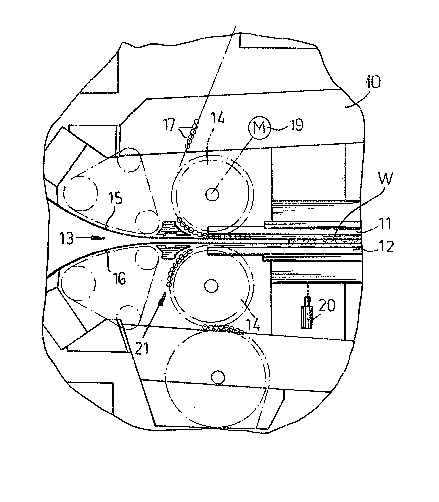Une partie des informations de ce site Web a été fournie par des sources externes. Le gouvernement du Canada n'assume aucune responsabilité concernant la précision, l'actualité ou la fiabilité des informations fournies par les sources externes. Les utilisateurs qui désirent employer cette information devraient consulter directement la source des informations. Le contenu fourni par les sources externes n'est pas assujetti aux exigences sur les langues officielles, la protection des renseignements personnels et l'accessibilité.
L'apparition de différences dans le texte et l'image des Revendications et de l'Abrégé dépend du moment auquel le document est publié. Les textes des Revendications et de l'Abrégé sont affichés :
| (12) Demande de brevet: | (11) CA 2085689 |
|---|---|
| (54) Titre français: | ROULEAU POUR PRESSE A COURROIES SANS FIN |
| (54) Titre anglais: | ROLLER FOR CONTINUOUS BELT PRESS |
| Statut: | Réputée abandonnée et au-delà du délai pour le rétablissement - en attente de la réponse à l’avis de communication rejetée |
| (51) Classification internationale des brevets (CIB): |
|
|---|---|
| (72) Inventeurs : |
|
| (73) Titulaires : |
|
| (71) Demandeurs : |
|
| (74) Agent: | BORDEN LADNER GERVAIS LLP |
| (74) Co-agent: | |
| (45) Délivré: | |
| (22) Date de dépôt: | 1992-12-17 |
| (41) Mise à la disponibilité du public: | 1993-06-19 |
| Licence disponible: | S.O. |
| Cédé au domaine public: | S.O. |
| (25) Langue des documents déposés: | Anglais |
| Traité de coopération en matière de brevets (PCT): | Non |
|---|
| (30) Données de priorité de la demande: | ||||||
|---|---|---|---|---|---|---|
|
18771
Abstract of the Disclosure
A belt press has a frame having horizontally extending
and vertically spaced upper and lower plates defining a horizon-
tally extending gap, respective upper and lower sets of drums
rotatable on the frame, respective upper and lower endless belts
spanned over the respective upper and lower sets of drums and
each having a working stretch lying between the plates, and re-
spective upper and lower sets of tubular rollers engaged between
the working stretches and the respective plates. Respective
upper and lower sets of rods traverse the respective rollers and
are connected together as upper and lower endless chains. A
drive connected to the drums advances the belts to move the work-
ing stretches horizontally in a transport direction to displace a
workpiece in the direction through the gap and the plates are
urged together with a pressure of between 300N/cm2 and 600N/cm2.
Each tubular roller has a wall thickness greater than 2mm, is
formed of a material such that it is not substantially deformed
when compressed diametrally between the respective plate and the
respective working stretch, has a mass which is smaller by a
factor of between 0.30 and 0.50 than a solid rod of identical
material and outside dimensions, and has a geometrical moment of
inertia that is smaller by a factor of between 0.50 and 0.65 than
a solid rod of identical material and outside dimensions.
- 11 -
Note : Les revendications sont présentées dans la langue officielle dans laquelle elles ont été soumises.
Note : Les descriptions sont présentées dans la langue officielle dans laquelle elles ont été soumises.

2024-08-01 : Dans le cadre de la transition vers les Brevets de nouvelle génération (BNG), la base de données sur les brevets canadiens (BDBC) contient désormais un Historique d'événement plus détaillé, qui reproduit le Journal des événements de notre nouvelle solution interne.
Veuillez noter que les événements débutant par « Inactive : » se réfèrent à des événements qui ne sont plus utilisés dans notre nouvelle solution interne.
Pour une meilleure compréhension de l'état de la demande ou brevet qui figure sur cette page, la rubrique Mise en garde , et les descriptions de Brevet , Historique d'événement , Taxes périodiques et Historique des paiements devraient être consultées.
| Description | Date |
|---|---|
| Inactive : CIB de MCD | 2006-03-11 |
| Inactive : CIB de MCD | 2006-03-11 |
| Le délai pour l'annulation est expiré | 1995-06-18 |
| Demande non rétablie avant l'échéance | 1995-06-18 |
| Réputée abandonnée - omission de répondre à un avis sur les taxes pour le maintien en état | 1994-12-19 |
| Inactive : Demande ad hoc documentée | 1994-12-19 |
| Demande publiée (accessible au public) | 1993-06-19 |
| Date d'abandonnement | Raison | Date de rétablissement |
|---|---|---|
| 1994-12-19 |
Les titulaires actuels et antérieures au dossier sont affichés en ordre alphabétique.
| Titulaires actuels au dossier |
|---|
| G. SIEMPELKAMP GMBH & CO. |
| Titulaires antérieures au dossier |
|---|
| KLAUS GERHARDT |